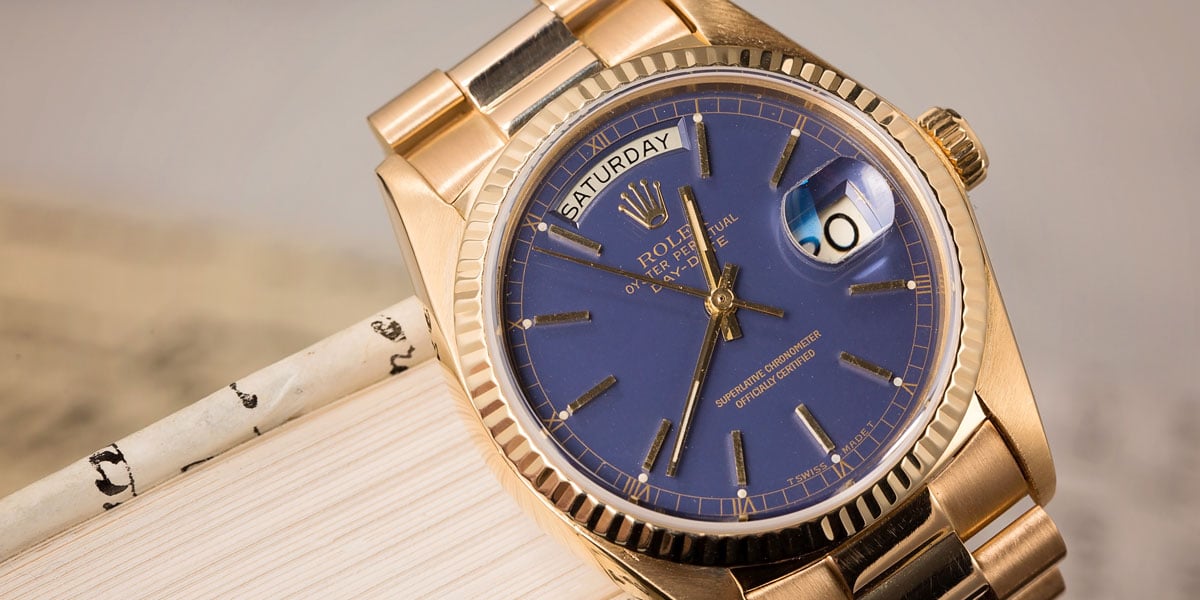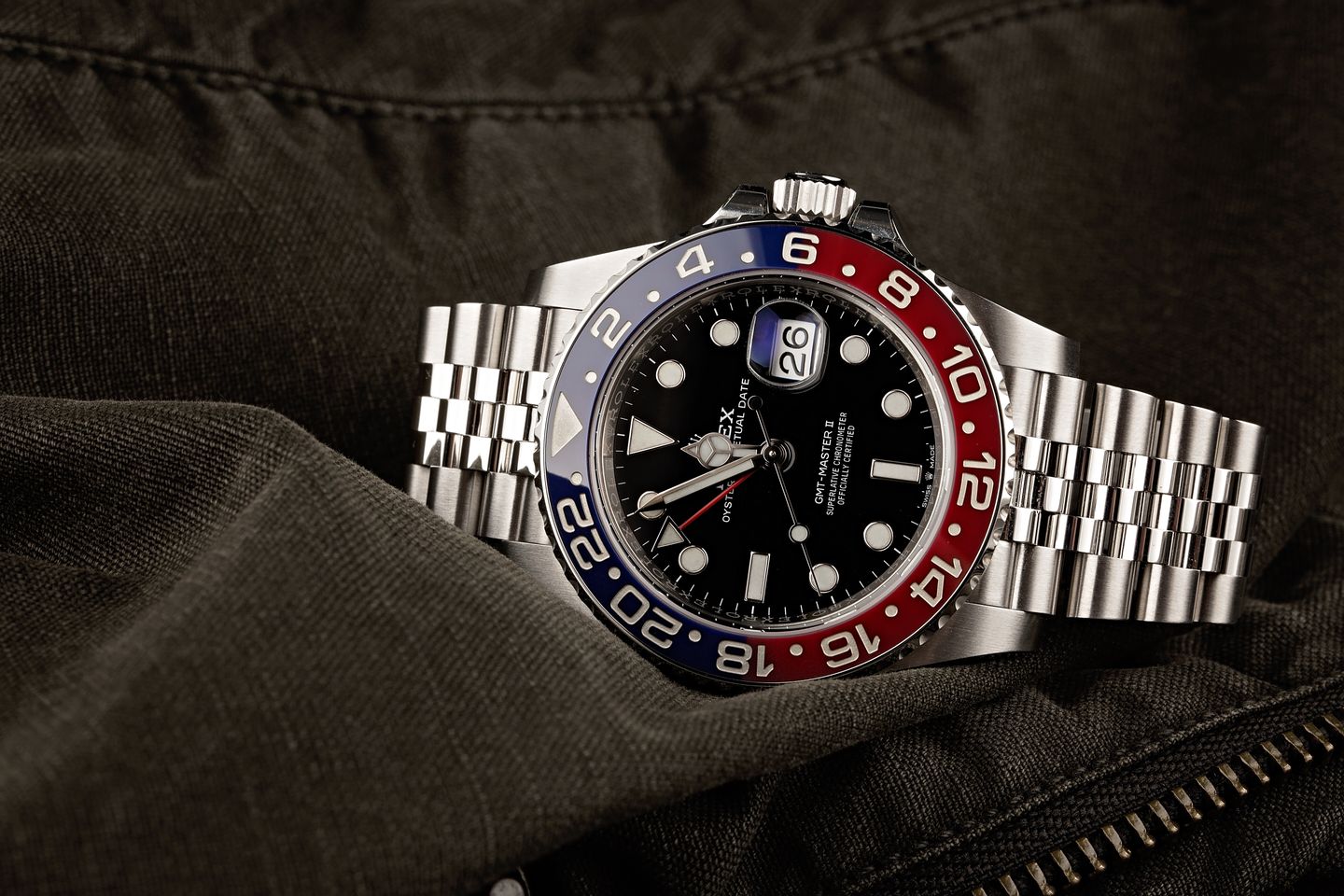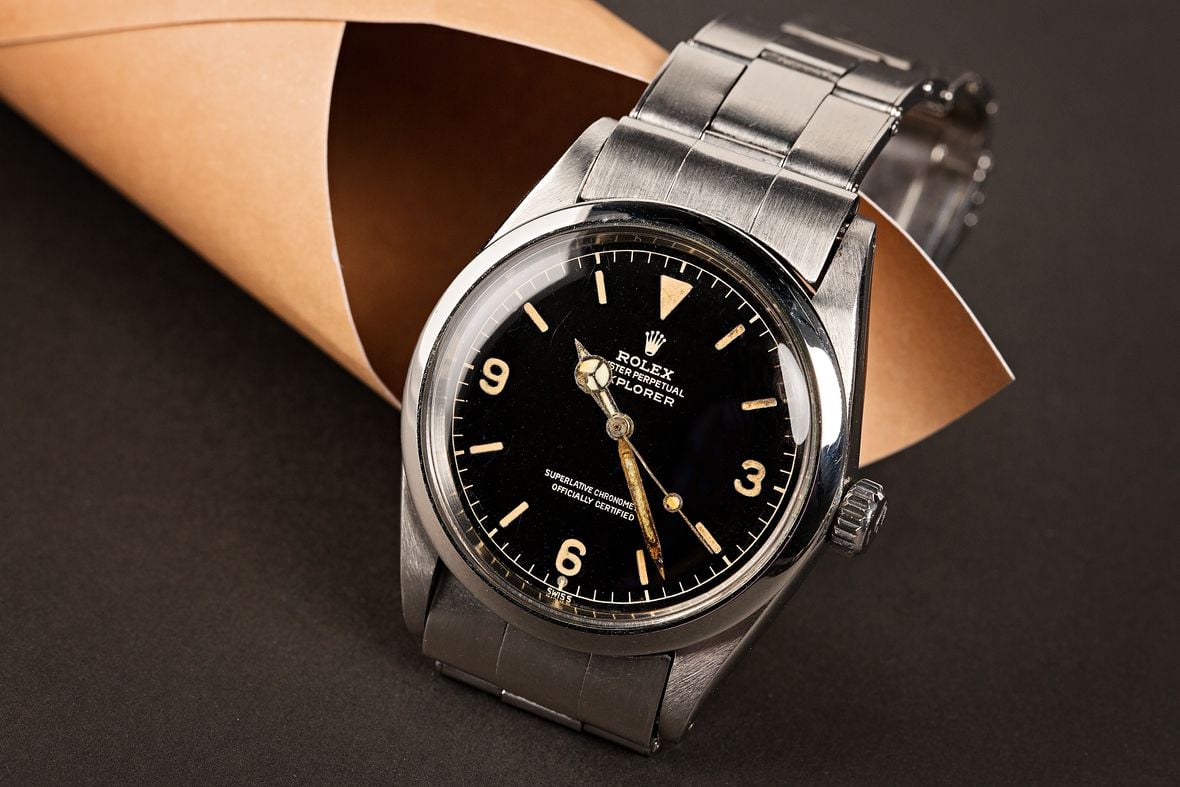For anyone who is an Explorer collector, the Rolex 16570 is likely a reference you own or would like to own. The Rolex Explorer II came to market in 1971 and was developed primarily for use in dark environments. In fact, the Explorer II’s ability to keep perfect time while working in low-visibility settings thanks to its AM/PM indicator made the watch the perfect choice for scientists, spelunkers, and arctic adventurers.
While the original Rolex Explorer II model, the ref. 1655, was developed as a watch with a day and night indicator, by the second generation, the Explorer II had graduated to become a GMT watch capable of displaying two time zones. What’s more, Rolex also added the choice of a white Polar dial to sit alongside the classic black option. This is now referred to as the Rolex Explorer II Polar watch by some collectors.
The Rolex Explorer II 16570 debuted in 1989 as the third iteration of the collection. It brought about a few upgrades from the preceding Rolex 16550 but retained the choice between a white Polar dial and a black dial. While each dial option functions the same, they couldn’t look more different. Rolex produced the Explorer II 16570 for more than two decades, which means this specific reference a handful of changes over the course of its manufacturing run. Join us as we go deep with the popular ref. 16570 and outline the differences between the white Polar dial vs. the black dial colorways.
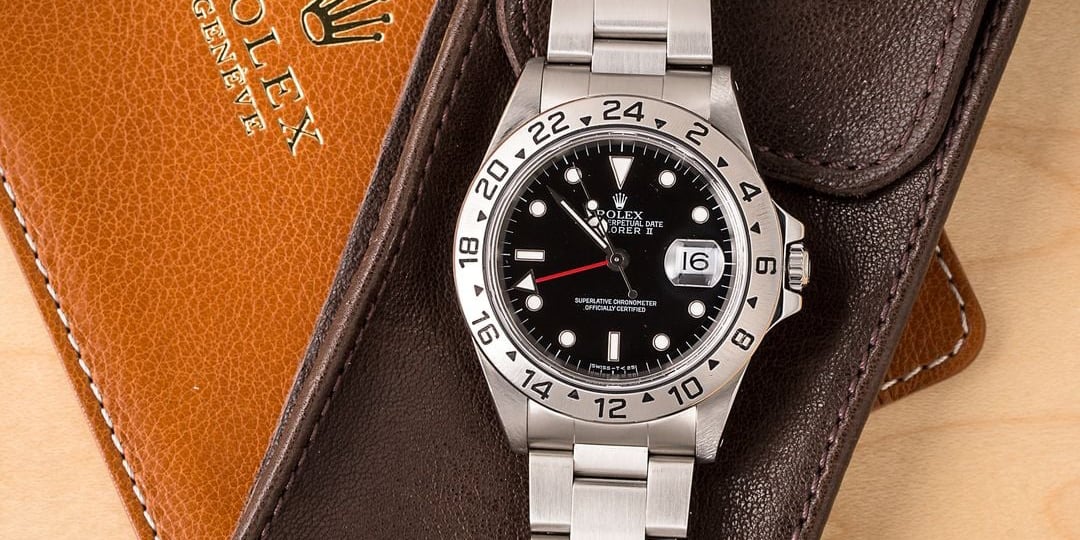
Rolex Explorer II 16570 Key Features
The Explorer II 16570 stands as a testament to Rolex’s commitment to excellence and adventure. This iconic timepiece features a robust 40mm stainless steel case, a highly legible dial with luminous markers, and a distinctive 24-hour hand. Powered by the reliable Rolex Caliber 3185 movement, the Explorer II 16570 offers the perfect blend of form and function that has made it a favorite among watch aficionados and globetrotters alike.
- Production years: 1989 – 2011
- Case: 40mm, stainless steel
- Bezel: Fixed, engraved with 24-hour scale
- Dial: Black dial or white “Polar dial”
- Lume: Tritium, Luminova, or SuperLuminova
- Crystal: Sapphire with Cyclops date magnification lens
- Functions: Local time (Mercedes hands), reference hour (red arrow-tipped 24-hour hand), date window at 3 o’clock
- Bracelet: Three-link Oyster bracelet
- Caliber: 3185 or 3186 automatic movement
- Water-resistance: 100 meters (330 feet)
While we focus on the 16570 here, it’s part of a broader lineage of exploration watches. For a comprehensive look at the entire series, including other references and historical context, check out our Rolex Explorer II review. This in-depth analysis covers the evolution of the Explorer II line and its significance in the world of horology.
Rolex Explorer II 16570 Timeline
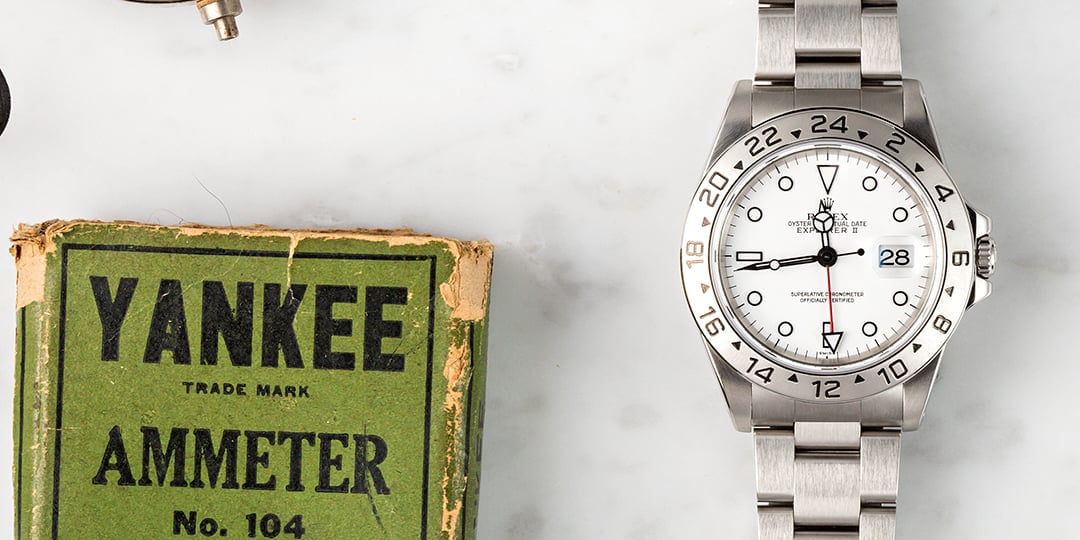
1971: Rolex introduces the AM/PM indicating Explorer II ref. 1655 specifically for spelunkers and exclusively available with a black dial
1985: Rolex introduces the Explorer II 16550, now fitted with a GMT dual-time function and available with a black or white dial
1989: Rolex introduces the Explorer II 16570 with a new caliber
1998: Rolex replaces the tritium lume of the Explorer II 16570 with Luminova
2000: Rolex replaces the Luminova lume of the Explorer II 16570 with SuperLuminova
2005: Rolex replaces the Explorer II 16570’s Caliber 3185 with Caliber 3186, which includes a blue Parachrom hairspring
2011: Rolex discontinues the Explorer II 16570 and replaces it with the larger Explorer II 216570
Rolex Explorer II 16570 Upgrades and Evolution
- Introduced in 1989 as the third-gen Explorer II
- New black surrounds on the white dial Explorer II 16570
- New Caliber 3185 automatic movement
When Rolex released the Explorer II 16570, the watch retained many of the same features as the preceding and short-lived Explorer II 16550. For instance, the Explorer II 16570 maintained the same 40mm stainless steel case, 24-hour engraved steel fixed bezel, steel Oyster bracelet, sapphire crystal, two hour hands (one traditional 12-hour and one long arrow-tipped 24-hour), and a date window topped with a Cyclops magnifying bubble. When used in conjunction with the 24-hour bezel, the red 24-hour hand could be set to another time zone other than local time.
The Explorer II line continued Rolex’s tradition of offering dial options in both black and white. The white dial variant, affectionately dubbed the “Polar Explorer II,” has long been a collector’s favorite. For those interested in a deeper dive into this specific model, our Rolex Explorer II Polar review offers comprehensive information and analysis.
The Explorer II 16570 Polar introduced a subtle yet significant change that caught the eye of many enthusiasts. Unlike its predecessors, this reference featured black surrounds for the hour markers, departing from the previous white gold ones. This striking detail not only enhanced the watch’s legibility but also became a defining characteristic, persisting on all subsequent white dial Explorer II models. Such design choices exemplify how small changes can have a lasting impact on a watch’s aesthetic and functionality, often becoming focal points in discussions about the evolution of this iconic timepiece.
Also new to the Explorer II 16570 was Caliber 3185. This self-winding movement with independently adjustable hour hands powered the Explorer II 16570 until 2005, when Rolex replaced it with Caliber 3186. Caliber 3186 not only benefited from the then-new blue Parachrom hairspring but also eliminated the slight wobble that the 24-hand of Caliber 3185-powered Explorer II 16570 watches had.
Other changes that occurred during the 22-year manufacturing period of the Explorer II 16570 watches included luminous material changes (from tritium to Luminova to SuperLuminova) and the addition of the ROLEX ROLEX ROLEX-engraved rehaut.
- 1998: Rolex replaces tritium (marked with SWISS T < 25 under 6 o’clock) with Luminova (marked with SWISS under 6 o’clock)
- 2000: Rolex replaces Luminova with SuperLuminova (marked with SWISS MADE under 6 o’clock)
- 2005: Caliber 3186 replaces Caliber 3185
- Mid-2000s: Rolex engraves rehauts with ROLEX ROLEX ROLEX as an anti-counterfeit measure
Explorer II 16570: The Classic Black Dial
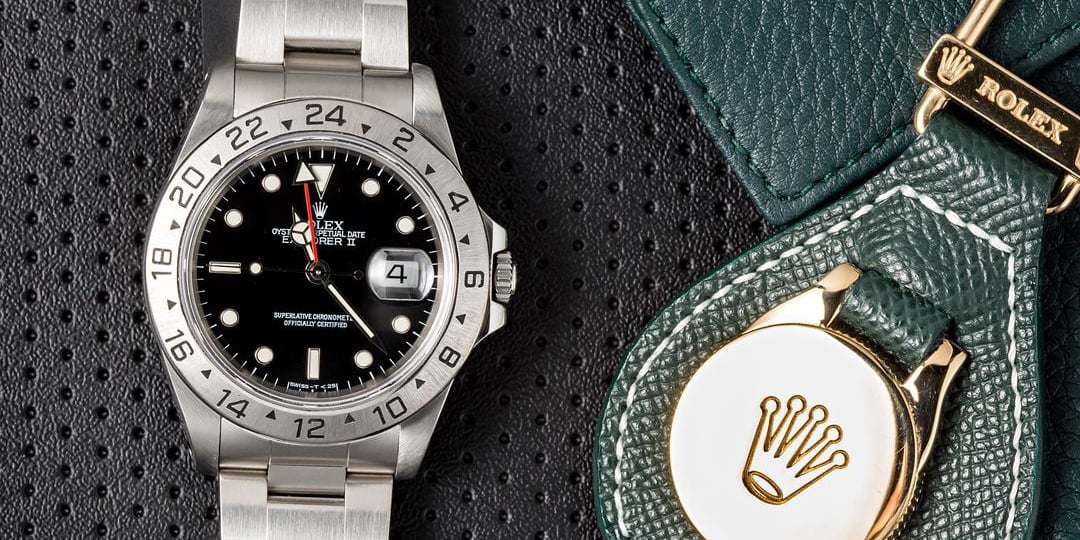
As mentioned, the Explorer II ref. 16570 came to market in 1989 and offered a stainless steel finish paired with a striking black dial. A luminous display provided an easy reading while the fixed bezel engraved with 24-hour graduations permitted the wearer to keep track of two time zones. The case measured a robust 40mm, complete with crown guards around the screw-down Twinlock winding crown. A scratch-resistant sapphire crystal and Caliber 3185 automatic movement were also new to the ref. 16570, adding to its appeal among collectors at the time.
But it’s the classic styling of the steel case and bracelet paired with the black dial that attracts so many Rolex enthusiasts. The black dial’s ability to transcend time means that the ref. 16570 is just as relevant today as it was the day it was released. Similar in style to other successful professional series watches, such as the Submariner and GMT-Master, the Explorer II’s black dial paired with the familiar Mercedes-style hands, lume-filled hour plots, and Cyclops magnified date window at 3 o’clock is a classic choice.
Explorer II 16570: The White “Polar” Dial
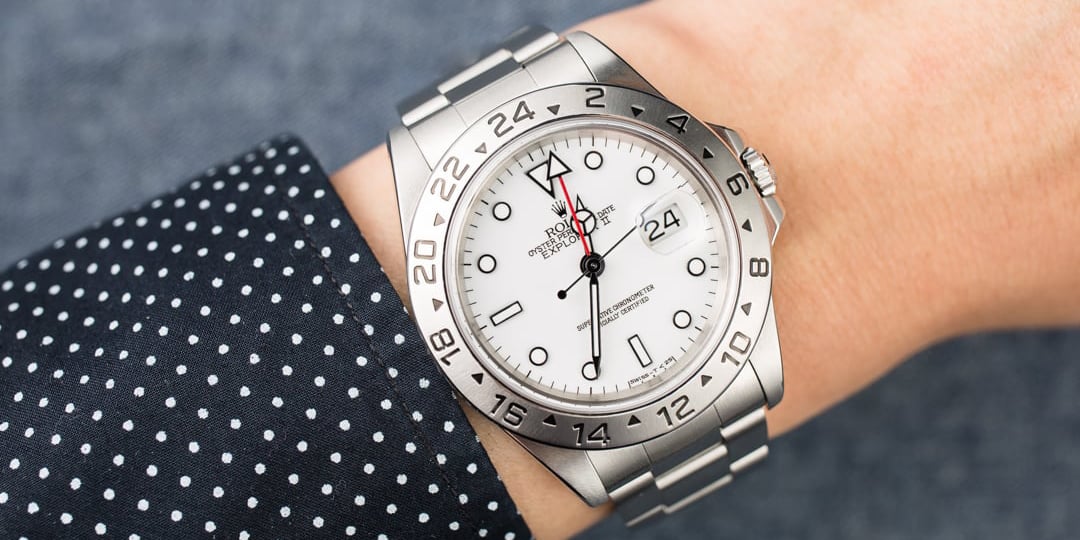
Dubbed the Rolex Polar, this cool variation of the Explorer ref. 16570 features a crisp white dial. Per usual, luminous hour markers and hands accompany the dial. However, the Rolex Polar Explorer II 16570 introduced black surrounds for better visibility. Just like its black dial counterpart, the Rolex Polar also features a 24-hour engraved bezel, a scratch-resistant sapphire crystal, a stainless steel 40mm Oyster case water-resistant to 100 meters, and a three-link Oyster bracelet.
Some collectors gravitate towards the white color of the Rolex Polar ref. 16570 over the black dial option, simply based on the fact that the white dial is unlike any other Rolex sports watch in the current catalog. The black surround no doubt adds immense character while enhancing the visibility of the dial. In short, this white dial Rolex Polar is an exceptional variation of the Explorer II ref. 16570. Generally speaking, Polar Explorer II variants are more expensive than their black dial counterparts on the secondary market.
Black or White Explorer II 16570?
Rolex discontinued the Explorer II 16570 in 2011 to make way for the 40th Anniversary Explorer II, the Rolex 216570. The Explorer II ref. 16570 was, in fact, the last 40mm Explorer II reference – the others that have followed have all sported larger 42mm cases, dials with more exaggerated details, and broader numerals on the engraved bezel. Therefore, the ref. 16570, whether in white or black, is the last classic Rolex Explorer II model.
We’ve already established that the black and white dial ref. 16570 function the same. So when comparing the two dial options, it comes down to personal preference toward the overall aesthetics of the watch. Do you like the black or white dial Explorer II 16570? Either way, you won’t regret adding this classic Rolex tool watch to your collection, no matter which dial variation you choose.
For those looking to acquire this iconic timepiece, Bob’s Watches offers a curated selection of authenticated Rolex 16570 for sale. As a trusted source in the pre-owned luxury watch market, we ensure that each Explorer II 16570 in our inventory undergoes rigorous inspection and verification processes. Whether you’re drawn to the crisp contrast of the Polar dial or the classic appeal of the black dial variant, you’ll find a range of options to suit your preferences. Our expertise in the Rolex market allows us to provide competitive pricing and expert guidance, making the process of adding this classic Explorer II to your collection both seamless and enjoyable.


